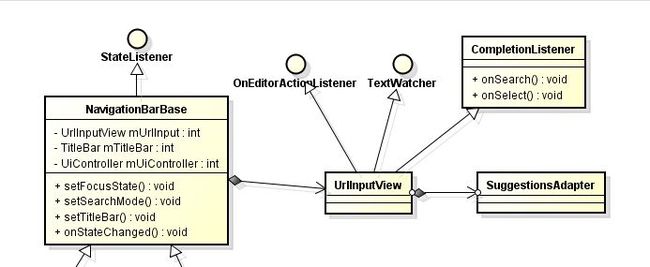Android Browser学习十二 UrlInputView
这段时间忙的要死, 但是还是不能忘掉自己的学习啊. 虽然读谷歌的代码确实有时候累觉不爱,但是现在却发现其实自己的不知不觉中进步, 现在基本上什么代码拿到手都不会心慌了.有时候还能把自己学习到的东西应用到项目中去, 这确实很美妙.
废话说到这里, 今天分享的是Browser的TitleBar模块, 也就是框计算模块,和chrome一样, android的浏览器的地址栏同样也是一个搜索框, 在UC和百度就应该叫做框计算了吧.其实看似很简单的需求,里面的内容还是很多的.
浏览器框计算的图片如下
读者可以一看就知道使用AutoCompleteTextView就可以实现, 确实是这样, android的chrome qq浏览器 都是类似的控件,
UC使用的其实是一个edittext + listview 可以更好的扩展各种业务, 删除等操作了.
我们还是回来看browser的实现也就是UrlInputView.java
UML
public class UrlInputView extends AutoCompleteTextView implements OnEditorActionListener, CompletionListener, OnItemClickListener, TextWatcher
果然是继承了这个AutoCT
他的初始化过程:
private void init(Context ctx) {
mInputManager = (InputMethodManager) ctx.getSystemService(Context.INPUT_METHOD_SERVICE);
setOnEditorActionListener(this);
//对于AutoCompleteTextView, 只要设置了他的Adapter 当用户输入某些字符的时候,他就会自己进行匹配了
//缺点是可能不好自己定制一些东西
mAdapter = new SuggestionsAdapter(ctx, this);
setAdapter(mAdapter);
setSelectAllOnFocus(true);
onConfigurationChanged(ctx.getResources().getConfiguration());
setThreshold(1);//输入一个字符就可以联想
setOnItemClickListener(this);
mNeedsUpdate = false;
addTextChangedListener(this);
mState = StateListener.STATE_NORMAL;
}
这个UrlInputView有三种状态
static interface StateListener {
static final int STATE_NORMAL = 0;
static final int STATE_HIGHLIGHTED = 1;
static final int STATE_EDITED = 2;
public void onStateChanged(int state);
}
在焦点发生变化, 触摸, 和输入状态发送变化的时候, 会更改UrlInputView的状态,
protected void onFocusChanged(boolean focused, int direction, Rect prevRect) {
super.onFocusChanged(focused, direction, prevRect);
int state = -1;
if (focused) {
if (hasSelection()) {
state = StateListener.STATE_HIGHLIGHTED;
} else {
state = StateListener.STATE_EDITED;
}
} else {
// reset the selection state
state = StateListener.STATE_NORMAL;
}
final int s = state;
post(new Runnable() {
public void run() {
changeState(s);
}
});
}
@Override
public boolean onTouchEvent(MotionEvent evt) {
boolean hasSelection = hasSelection();
boolean res = super.onTouchEvent(evt);
//
//Return the masked action being performed, without pointer index information. Use getActionIndex() to return the index associated with pointer actions.
// 翻译意思大概:返回经过掩码的action,没有触控点索引信息. 通过getActionIndex()来得到触控操作点的索引.
if ((MotionEvent.ACTION_DOWN == evt.getActionMasked())
&& hasSelection) {
postDelayed(new Runnable() {
public void run() {
changeState(StateListener.STATE_EDITED);
}}, POST_DELAY);
}
return res;
}
@Override
public void onTextChanged(CharSequence s, int start, int before, int count) {
if (StateListener.STATE_HIGHLIGHTED == mState) {
changeState(StateListener.STATE_EDITED);
}
}
这个状态的变化会回调到Titlebar的onStateChanged函数 , Titlebar的各个图标随之会变化
UrlInputView是一个下拉列表, 所以自然有他的Adapter也就是 SuggestionsAdapter
其初始化
public SuggestionsAdapter(Context ctx, CompletionListener listener) {
mContext = ctx;
mSettings = BrowserSettings.getInstance();
mListener = listener;
mLinesPortrait = mContext.getResources().
getInteger(R.integer.max_suggest_lines_portrait);
mLinesLandscape = mContext.getResources().
getInteger(R.integer.max_suggest_lines_landscape);
//添加过滤器, AutoCompleteTextView 会通过getFilter拿到
//这个自定义的filter 这样
//这样每当textview输入文字时候 就会先 mAdapter.getItem(position);
//mFilter.convertResultToString(item),
//filter就会去拿相关数据了
mFilter = new SuggestFilter();
addSource(new CombinedCursor());
}
这里的Filter 是根据输入的内容, 过滤出结果列表的功能, 这是给AutoCT使用的, 我们自定义了过滤的内容
/*
* 联想过滤类 根据textview的输入请求数据
*
* 过滤器通过过滤模式来约束数据,通常由实现了Filterable接口的子类来生成。
* 过滤操作是通过调用 filter(CharSequence) 或者
* filter(CharSequence, android.widget.Filter.FilterListener)这些异步方法来完成的。
* 以上方法一旦被调用,过滤请求就会被递交到请求队列中等待处理,
* 同时该操作会取消那些之前递交的但是还没有被处理的请求。
*/
class SuggestFilter extends Filter {
/*这里是点一下把下面的text 填充到edittext中*/
@Override
public CharSequence convertResultToString(Object item) {
if (item == null) {
return "";
}
SuggestItem sitem = (SuggestItem) item;
if (sitem.title != null) {
return sitem.title;
} else {
return sitem.url;
}
}
/* 异步发送联想过滤*/
void startSuggestionsAsync(final CharSequence constraint) {
if (!mIncognitoMode) {
new SlowFilterTask().execute(constraint);
}
}
/**
* 是否出来空查询 默认是false
*/
private boolean shouldProcessEmptyQuery() {
final SearchEngine searchEngine = mSettings.getSearchEngine();
return searchEngine.wantsEmptyQuery();
}
/*AutoCompleteTextview mFilter.filter 最后调用到子类的这个函数*/
@Override
protected FilterResults performFiltering(CharSequence constraint) {
FilterResults res = new FilterResults();
if (mVoiceResults == null) {
if (TextUtils.isEmpty(constraint) && !shouldProcessEmptyQuery()) {
res.count = 0;
res.values = null;
return res;
}
startSuggestionsAsync(constraint);
List<SuggestItem> filterResults = new ArrayList<SuggestItem>();
if (constraint != null) {
for (CursorSource sc : mSources) {
sc.runQuery(constraint);
}
/*把mSources 中的数据 放到 filterResults中*/
mixResults(filterResults);
}
synchronized (mResultsLock) {
mFilterResults = filterResults;
}
SuggestionResults mixed = buildSuggestionResults();
res.count = mixed.getLineCount();
res.values = mixed;
} else {
res.count = mVoiceResults.size();
res.values = mVoiceResults;
}
return res;
}
/*把mSources 中的数据 放到 results中*/
void mixResults(List<SuggestItem> results) {
int maxLines = getMaxLines();
for (int i = 0; i < mSources.size(); i++) {
CursorSource s = mSources.get(i);
int n = Math.min(s.getCount(), maxLines);
maxLines -= n;
boolean more = false;
for (int j = 0; j < n; j++) {
//取出一个item后 mCursor 下移一个 添加下一个item
results.add(s.getItem());
more = s.moveToNext();
}
}
}
@Override
protected void publishResults(CharSequence constraint, FilterResults fresults) {
if (fresults.values instanceof SuggestionResults) {
mMixedResults = (SuggestionResults) fresults.values;
notifyDataSetChanged();//最后通知list更新各种数据
}
}
}
这个Filter的调用来自AutoCompleteTextView : 的 TextWAtcher, 然后就开始进行对数据的过滤
/**
* This is used to watch for edits to the text view. Note that we call
* to methods on the auto complete text view class so that we can access
* private vars without going through thunks.
*/
private class MyWatcher implements TextWatcher {
public void afterTextChanged(Editable s) {
doAfterTextChanged();
}
public void beforeTextChanged(CharSequence s, int start, int count, int after) {
doBeforeTextChanged();
}
public void onTextChanged(CharSequence s, int start, int before, int count) {
}
}
void doAfterTextChanged() {
if (mBlockCompletion) return;
// if the list was open before the keystroke, but closed afterwards,
// then something in the keystroke processing (an input filter perhaps)
// called performCompletion() and we shouldn't do any more processing.
if (DEBUG) Log.v(TAG, "after text changed: openBefore=" + mOpenBefore
+ " open=" + isPopupShowing());
if (mOpenBefore && !isPopupShowing()) {
return;
}
// the drop down is shown only when a minimum number of characters
// was typed in the text view
if (enoughToFilter()) {
if (mFilter != null) { //在构造器中拿到的Filter
mPopupCanBeUpdated = true;
performFiltering(getText(), mLastKeyCode); //至于AutoCT是继承的Edittext
}
} else {
// drop down is automatically dismissed when enough characters
// are deleted from the text view
if (!mPopup.isDropDownAlwaysVisible()) {
dismissDropDown();
}
if (mFilter != null) {
mFilter.filter(null);
}
}
}
其实AutoCT 使用的就是一个 ListPopupWindow 来展示下拉上拉的popupwindow
public AutoCompleteTextView(Context context, AttributeSet attrs, int defStyle) {
super(context, attrs, defStyle);
mPopup = new ListPopupWindow(context, attrs,
com.android.internal.R.attr.autoCompleteTextViewStyle);
mPopup.setSoftInputMode(WindowManager.LayoutParams.SOFT_INPUT_ADJUST_RESIZE);
mPopup.setPromptPosition(ListPopupWindow.POSITION_PROMPT_BELOW);
综上, UrlInputView 是一个高度定制的AutoCT, 如果让我们去做可能用的是一个个控件去组合, 但是谷歌只用了一个AutoCT来实现, 可真的看出来Android的控件就是这群人写的. UrlInputView并且包括了联想词, 历史词等复杂的逻辑.
值得我们去学习借鉴.
UrlinputView 通过自定义的 SuggestionsAdapter, 在adapter中实现由两个Cursor组成的Filter从而实现了搜索联想词功能, 我们会在下一章做介绍

